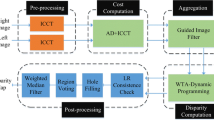Abstract
A progressive framework is proposed for dense stereo matching to solve problems caused by weaktexture and occlusion in this paper. The main idea is that disparity is extracted progressively, from coarse to fine, from sparse to dense. First, a coarse disparity map is obtained by the segment-based pre-matching method, in which horizontal and vertical segment matching are performed in parallel and pre-matching results are merged to preserve more details. Second, disparity diffusion is performed to roughly estimate disparity values for miss-matched points. Third, a probabilistic approach is used for disparity refinement, taking into account stereo prior, image likehood and disparity smoothness. Experiments are made on the Middlebury benchmark to demostrate the effectiveness of the proposed algorithm.
Similar content being viewed by others
References
L. Nalpantidis, G. C. Sirakoulis, and A. Gasteratos, “Review of stereo vision algorithms: from software to hardware,” Int. J. Optomechatron. 2 4, 435–462 (2008).
L. Nalpantidis and A. Gasteratos, “Stereo vision for robotic applications in the presence of non-ideal lighting conditions,” Image Vision Comput. 28 6, 940–951 (2010).
J. Joglekar, S. S. Gedam, and B. K. Mohan, “Image matching using SIFT features and relaxation labeling technique–a constraint initializing method for dense stereo matching,” IEEE Trans. Geosci. Remote Sensing 52 9, 5643–5652 (2014).
D. G. Lowe, “Distinctive image features from scaleinvariant keypoints,” Int. J. Comput. Vision 60 2, 91–110 (2004).
A. Hosni, M. Bleyer, and M. Gelautz, “Secrets of adaptive support weight techniques for local stereo matching,” Comput. Vision Image Understand. 117 6, 620–632 (2013).
K. J. Yoon and I. S. Kweon, “Locally adaptive supportweight approach for visual correspondence search,” in Proc. Computer Vision and Pattern Recognition Conf. CVPR 2005 (San Diego, 2005), pp. 924–931.
K. J. Yoon and I. S. Kweon, “Adaptive support-weight approach for correspondence search,” Pattern Anal. Mach. Intellig. 28 4, 650–656 (2006).
K. J. Yoon and I. S. Kweon, “Stereo matching with the distinctive similarity measure,” in Proc. Computer Vision Conf. ICCV 2007 (Rio de Janeiro, 2007), pp. 1–7.
A. Geiger, M. Roser, and R. Urtasun, “Efficient largescale stereo matching,” in Proc. Computer Vision Conf. ACCV 2010 (Springer, 2011), pp. 25–38.
L. Hong and G. Chen, “Segment-based stereo matching using graph cuts,” in Proc. Computer Vision and Pattern Recognition Conf. CVPR 2004 (Washington, 2004), Vol. 1, pp. I-74–I-81.
D. L. Wang and K. Bin Lim, “Obtaining depth map from segment-based stereo matching using graph cuts,” J. Visual Commun. Image Representat. 22 4, 325–331 (2011).
M. Bleyer and M. Gelautz, “A layered stereo matching algorithm using image segmentation and global visibility constraints,” ISPRS J. Photogrammetry Remote Sensing 59 3, 128–150 (2005).
L. Piovano, et al., “Acyclic belief propagation for stereo matching,” Pattern Recogn. Image Anal. 19 3, 508–527 (2009)
C. Zinner, et al., “An optimized software-based implementation of a census-based stereo matching algorithm,” in Advances in Visual Computing (Springer, 2008), pp. 216–227.
J. Lu, et al., “Patch match filter: efficient edge-aware filtering meets randomized search for fast correspondence field estimation,” in Proc. Computer Vision and Pattern Recognition Conf. (CVPR) (Portland, 2013), pp. 1854–1861.
X. Mei, et al., “Segment-tree based cost aggregation for stereo matching,” in Proc. Computer Vision and Pattern Recognition Conf. (CVPR) (Portland, 2013), pp. 313–320.
Author information
Authors and Affiliations
Corresponding author
Additional information
The article is published in the original.
Bingxi Jia (born 1991) received his B.E. degree in Control Science and Engineering, Zhejiang University, China, in 2012. He is currently working toward the Ph.D. degree in the College of Control Science and Engineering, Zhejiang University.
His research interests include computer vision and vision based control.
Shan Liu (born 1970) received his B.S. degree in applied mathematics from University of Science and Technology of China in 1992, and M.S. and Ph.D. degrees in control science and engineering from Zhejiang University, China in 1995 and 2002, respectively. He is currently an associate professor in the College of Control Science and Engineering, Zhejiang University. Author of 40 publications.
His research interests include computer vision and learning control.
Zhuoyang Du (born 1994) is an undergraduate student from Zhejiang University majoring in Control Science and Engineering.
Her research interests include computer vision and robot visual servo control.
Rights and permissions
About this article
Cite this article
Jia, B., Liu, S. & Du, Z. A progressive framework for dense stereo matching. Pattern Recognit. Image Anal. 26, 294–301 (2016). https://doi.org/10.1134/S1054661816020036
Received:
Published:
Issue Date:
DOI: https://doi.org/10.1134/S1054661816020036




